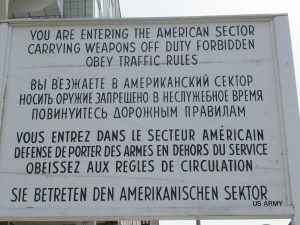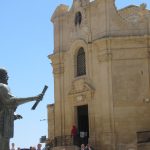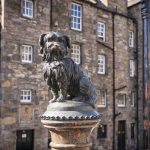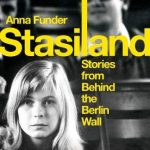The Berlin Wall is undoubtedly one of the 20th century’s most fascinating stories and this post will give you a little background, then describe three places you can visit in Berlin today to see what’s left of it and to find out more: Checkpoint Charlie, the Berlin Wall Memorial Site and the East Side Gallery.
The Impact of the Berlin Wall

The Berlin Wall made a huge impact on the author Rory MacLean when he saw it as a teenager, as he explains in the introduction to his book Berlin: Imagine a City: ‘At the heart of the continent were watchtowers, barbed wire and border guards, instructed to shoot fellow citizens who wanted to live under a different government.’
Other authors documented its effect on ordinary Berliners; the wedding couple, still in their finery, waving across the wall to parents in the West who had been unable to see them marry; the new parents, standing on the viewing platforms at Potsdamer Platz and holding up their baby, so the grandparents on the other side could catch a glimpse of it.
A Little History

When Berlin was divided into 4 sectors after World War II, no-one realised that the Soviet sector would gradually peel away from the other three – American, British, French – until it was part of a separate country. In June 1961, the East German First Secretary, Walter Ulbricht, said ‘No-one intends to build a wall.’ Weeks later, on August 13th, 400 trucks of barbed wire were brought into the city in the middle of the night. By morning, the barricade was up. By the end of the month, so was the wall.
The Berlin Wall ran from north to south through the middle of the city, leaving Unter den Linden in the East and the Tiergarten and the Ku’damm in the West. It sliced through the Potsdamer Platz and went right past the Brandenburg Gate. And it stayed put for the next 28 years.
Checkpoint Charlie
Checkpoint Charlie was one of the few places where those with the right papers could cross between the East and West Berlin, hence the signs still there stating ‘You are Leaving the American Sector’. It’s also where the terrifying stand-off between American and Soviet tanks took place in October 1961. Both were ordered to fire if they were fired at and for a day, until a diplomatic solution was found, the world held its breath.

From the Kochstrasse U-Bahn station, walk up Friedrichsstrasse towards the checkpoint and you will pass information panels telling the whole story, from the building of the wall to its fall. There are weighty quotations from politicians like Winston Churchill who understood the calamity immediately: ‘From Stettin in the Baltic to Trieste in the Adriatic, an Iron Curtain has descended across the continent’. And President Kennedy expressed his solidarity with all Berliners, saying, in slightly shaky German, ‘Ich bin ein Berliner’.
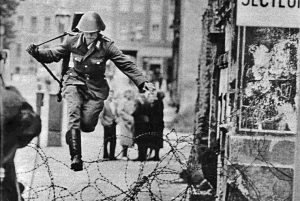
The Haus am Checkpoint Charlie is a museum which details the amazing escape attempts made by those trying to get out of East Berlin, by land, by air or by tunnelling underground. Here you will see suitcases and a speaker box into which people crammed themselves in order to be driven over the border. There are adapted cars, where an escapee hid under the bonnet, mini-submarines, hot air balloons and hang gliders. And behind it all, the stories of the 5000 or so people who managed to escape, some of them even border guards. Remembered too are thousands more East Berliners who tried to escape, but failed. Some of them died in the attempt,
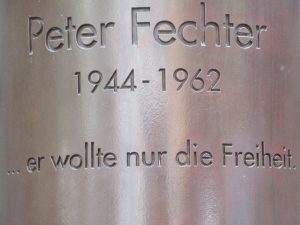
Very close to Checkpoint Charlie, in Zimmerstrasse, is a moving monument to Peter Fechter, an 18 year-old builder who was shot by the border guards when trying to jump over the wall. He fell into no-man’s land and bled to death as the guards looked on, a scene captured in photographs which later went round the world. The monument shows the date, 17th August 1962, and the words ‘Er wollte nur die Freiheit’, ‘He simply wanted freedom.’
The Berlin Wall Memorial
The S-Bahn station Nordbahnhof is very near the Berlin Wall Memorial’s documentation centre, where you can see films, photographs and documents. From there, you can walk through a 1.4 km outdoor museum, up to the Bernauer Strasse U-Bahn, past sections of the wall which are still standing and lots of information panels to tell the story.

You can read all about the death strip running along the eastern side of the wall, with its floodlights, watch towers and border guards. The wall ran right down this street and when the East German authorities blocked up the ground-floor doors and windows, people tried to escape by jumping out from the first floor. Plaques in the pavement remember those killed in the attempt, either from the fall or because they were shot. An example of those who made it is the Knittel family – parents and 3 year-old daughter – who arranged to be caught in a net on the western side by members of the Fire Brigade. Others escaped through tunnels they had painstakingly dug under the road.
The East Side Gallery
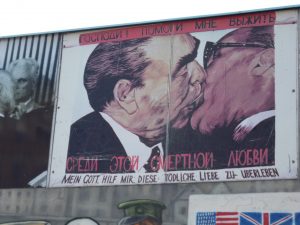
Here too, sections of the wall remain standing, decorated with brightly coloured murals painted by artists from over 20 countries after the wall’s fall in 1989. Today, it’s an open-air gallery, a 1.3km stroll beside the River Spree. One shows the Russian leader Brezhnev exchanging a ‘socialist fraternal kiss’ with Erich Honecker, the East German leader. Others depict a Trabant, (an East German car) breaking gleefully through the wall, 2 doves flying along holding the Brandenburg Gate and slogans such as ‘There are many walls to be knocked down.’
The nearest U-Bahn station is Warschauer Strasse which is on both Lines 1 and 3. It’s possible to book a guided tour along here: for example, here, or here.
The Fall of the Wall
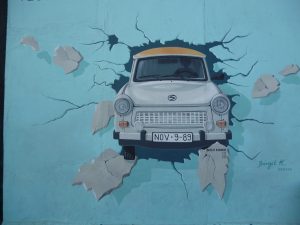
On November 4th 1989, thousands of people gathered in Berlin’s Alexanderplatz to demand an end to travel restrictions and, a few days later an East German official, Gunther Schabowski, announced in a live tv press conference that this would happen. Asked when by a journalist, he seemed unsure, but said ‘As far as I know, immediately.’
That was it! Berliners from both sides rushed to the wall with pickaxes and the world looked on incredulously as they danced along it, broke it down and rushed through to greet each other in delirious excitement. The cellist Rostropovich, ‘seized with joy’, flew immediately from Paris to play an impromptu concert at the broken wall. A few weeks later, Leonard Bernstein conducted Christmas concerts in both East and West Berlin, where a choir uniting singers from both halves of the city sang ‘Ode to Joy’ with one little change to the wording. Not ‘An die Freude’, but ‘An die Freiheit.’ The new version meant ‘Ode to Freedom.’
Listen to the podcast
Suggested Reading
Berlin: Imagine a City by Rory MacLean
Berlin Biography of a City by Barney White-Spunner
Tunnel 29 by Helena Merriman
(Love, Espionage and Betrayal: the True Story of an Extraordinary Escape Beneath the Berlin Wall)
Links for this post
Checkpoint Charlie
The Haus am Checkpoint Charlie Museum
The Berlin Wall Memorial Site
The East Side Gallery
Guided tours of the East Side Gallery here or here
Last Updated on November 21, 2024 by Marian Jones


